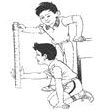问题
单项选择题
用如图所示的方法可以研究不同人的反应时间,设直尺从静止开始自由下落到直尺被受测者抓住,直尺下落的竖直距离为h,受测者的反应时间为t,则下列关于t和h的关系正确的是()

A.t∝h
B.t∝
C.t∝
D.t∝h2
答案
参考答案:A
解析:
直尺做自由落体运动,由位移公式可以求得t和h的关系.由自由落体运动的位移 ,可得
,可得 ,所以C正确。
,所以C正确。
故选C。
用如图所示的方法可以研究不同人的反应时间,设直尺从静止开始自由下落到直尺被受测者抓住,直尺下落的竖直距离为h,受测者的反应时间为t,则下列关于t和h的关系正确的是()

A.t∝h
B.t∝
C.t∝
D.t∝h2
参考答案:A
解析:
直尺做自由落体运动,由位移公式可以求得t和h的关系.由自由落体运动的位移 ,可得
,可得 ,所以C正确。
,所以C正确。
故选C。